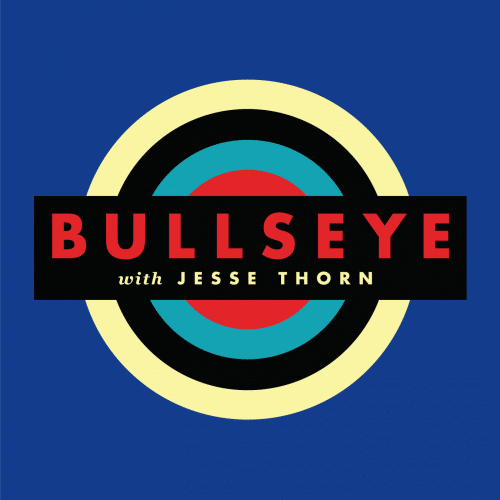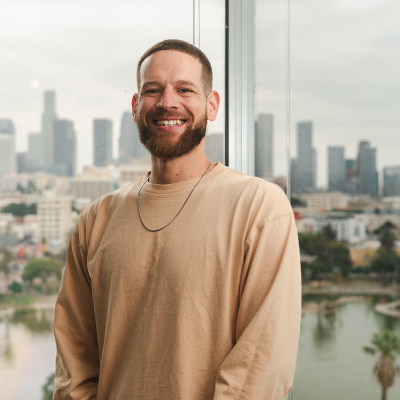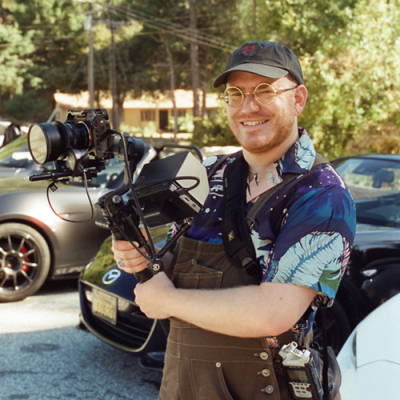Transcript
[00:00:00]
(ADVERTISEMENT)
Transition: Gentle, trilling music with a steady drumbeat plays under the dialogue.
Promo: Bullseye with Jesse Thorn is a production of MaximumFun.org and is distributed by NPR.
Music: “Huddle Formation” from the album Thunder, Lightning, Strike by The Go! Team—a fast, upbeat, peppy song. Music plays as Jesse speaks, then fades out.
Jesse Thorn: It’s Bullseye. I’m Jesse Thorn. Now, every now and then, we bring guests onto our show for a special segment called I Wish I Made That. Now, usually when we do this segment, we talk with—you know—a writer about a movie that they wish they’d made, or a sitcom a standup comic wishes that they’d worked on. But today, we aren’t doing that. We’re talking about food instead.
Our guest is René Redzepi, one of the greatest chefs in the world, and he’s going to talk about a dish he wishes he’d invented. We’ll elaborate on that in a second, I promise. But first, introducing Redzepi. He founded the restaurant Noma in Copenhagen. Noma has, for decades, been one of the best restaurants in the world. They serve a fine dining version of Nordic cuisine, and that in and of itself isn’t revolutionary. But their approach to it was. The menu is fiercely local, sometimes foraged, usually vegetable-focused—the kinds of things that you see on menus pretty much everywhere these days, except that when they opened Noma, it was a new old idea.
Redzepi recently announced that Noma would close later this year. He’s followed that news with a little bit of a career pivot to TV host. His show, Omnivore, just premiered on Apple TV+. In each episode, Redzepi talks about one ingredient—maybe tuna or rice or bananas—how those ingredients became ingredients, and how society and capitalism have changed those ingredients. Sometimes for the better, sometimes for the worse. Like, for example, on the episode about chili peppers, he explores the factory where Tabasco is made.
Transition: A whooshing sound.
Clip:
Music: Dreamy, atmospheric background music.
René Redzepi (Omnivore): I grew up between Macedonia and one of the least spicy countries in the world: Denmark. Love it or loathe it, for many years, Tabasco was the only game in town—a gateway to a spicier world. I doubt anyone had a clue about the source of this mysterious red sauce. This is the story of the family and a 150-year-old recipe from a southern Louisiana salt marsh that helped set the world on fire.
Transition: A whooshing sound.
Jesse Thorn: Anyway, we were so excited to invite René Redzepi on Bullseye and ask him about the dish he wishes he’d made. He came ready with a great one! What’s it called? (Chuckles.) Well, I don’t want to embarrass myself, so I will let René pronounce it.
René Redzepi: My name is René Redzepi. My thing I wish I made is a dish called the Gargouillou.
Music: Spirited orchestral music with prominent strings.
René Redzepi: The Gargouillou is a strange name for a dish. But it’s a dish that has changed—I would say—fine dining, perhaps even cooking. Gargouillou is a dish of vegetables, some cooked, some raw; an expression of seasonality of the moment served onto a plate.
When you have the Gargouillou, you see in front of you a white porcelain plate. It’s full of things. There are leaves, all the wild leaves you can imagine. There’s also flowers. There might be a nasturtium in the right corner. There might be a puree. I think it’s celery. There’s also something broccoli—I see that as well—in thin slices, marinated with a touch of hazelnut oil. All the different carrots in all its shapes and sizes are there. Some are cooked, some are raw. I see beets cooked in an oven. They’re sweet, they’re glazed with sweet butter. Flakes of salt are on there. I see lots of lettuces, but not the ones you think of. These are the tiny shoots. Crisp, nutty, juicy. It’s just a perfect microcosmos of what’s in season. The different textures. When you bite into it, it’s truly a masterpiece.
The Gargouillou is created by a legendary French chef. His name is Michel Bras.
[00:05:00]
He is completely unknown in the big scale of things. Of course, most cooks know him. But even if you ask a 25-year-old cook, I don’t even think they know Michel Bras anymore. But he was one of the most influential people in the past three/four decades in cooking.
It’s a good question why Michel Bras is not more well known than he is. He’s a very introverted guy as well. He doesn’t speak English. That’s definitely also a disadvantage in this day of age.
Clip: Michel Bras speaking softly in French with the sounds of cutlery on plates in the background.
René Redzepi: I think he’s also just like an extraordinary nature freak, you know. He just wants to go hiking or smell the flowers. And he’s from a region in France, a fairly unknown region, called Laguiole. And he has a restaurant that is—or was, at least—one of the most revolutionary restaurants of its time. His restaurant, he opened a second version of it in mid-‘90s on a hillside on a mountain range in the Laguiole region of France.
At the time, France was a place where people sat in big plush chairs with velvet linen, big old candelabras, very old-school and classic. And he opened what looked like a UFO had landed on the hillside in the middle of nowhere. And he cooked this outrageous modernistic food that today still is modern but seems as if it fits this time. But back then he was decades ahead of all of us.
(The music builds in intensity.)
Michel Bras is deeply rooted in his region. And he knows every nook and cranny, all the different landscapes, the microclimates. He knows what’s edible, what’s not edible. He knows when strange roots come into season and how to cook them. And so, he decided to put it all together on a plate. And it does sound like just a cooked salad dish of vegetables. But the way it’s cooked together, the way that each of them is cooked individually—some barely cooked, others raw, some cooked all the way through, some are pureed. And you would think that when eating it, it all blends together and tastes sort of nothing or just of greens.
(Music cuts out.)
But somehow you can still taste each individual flavor by itself, which is what makes Gargouillou outstanding, incredible, transformative.
Music: Lilting, gentle orchestral music fades in.
René Redzepi: Even though that I heard about the dish, and I saw it first through a cookbook, there was no way I could ever cook a Gargouillou. The name itself, Gargouillou, is his name. He invented it to express this dish. All cooks know that the Gargouillou is Michel Bras and is that serving. But the idea of the Gargouillou is everywhere. Which is: cook what’s there.
So, the funny thing about the Gargouillou and meeting Michel Bras—the creator of the Gargouillou for the first time—was that didn’t even happen at his restaurant. That happened in Copenhagen. I invited him to our symposium called Mad Symposium. I asked him, “Can you come and explain to us why and when did that happen? How do you come up with something like that?”
And so, he arrived to Copenhagen empty handed. I thought he’d bring everything. And then he asked to go to the market and to the farms. And so, he spent a day and a half figuring out what was available. And then he cooked a sort of a Danish version of Gargouillou on stage when talking. So, the first Gargouillou I had was actually in Copenhagen, cooked by Michel Bras with Scandinavian ingredients. And it was of course fantastic, but I always felt something was missing. Then the year after. And we’re talking—oh, is this 12 years ago? I, you know, was actually very successful at Noma by then already.
Me and my wife, we went to Michel Bras and had the real Gargouillou. I mean, going to Michel Bras definitely is a difficult thing to do.
[00:10:00]
It’s much easier to just go to Paris. And being an extra rare thing makes it extra special when you finally get there. And you could say, when you do that, then things perhaps taste extra good (chuckles) because you’ve made that extra effort.
The thing about Michel Bras is that he was so ahead of his time. It was the most modern restaurant, away from everything. You know, it’s made as an expression of a place, his region, and you have to go there to actually have the real thing. When I look at the Gargouillou, I see colors. I see nature. I see textures. I see flavors. I see fragrance—even though you don’t see fragrance, but looking at it you want to smell it, because it’s so beautiful.
It has greatly influenced Noma. He has greatly influenced my work. He was one of the most influential people in the past three/four decades in cooking.
I wish I made the Gargouillou, because it’s a stroke of genius that very few do. But on the other hand, it has fueled and inspired me so much that perhaps I wouldn’t have been the one I am if I would have done that. But the Gargouillou was always full of things. The way I see it is that that’s how nature is. Sometimes we’ll look at a landscape and we’ll say it’s simple, a cornfield. But then if you dive into it, it isn’t. There are all sorts of things at play if you just look closer. And I think that’s what he’s showing us. It’s just so perfect. And perfection never happens. Except, perhaps, with the Gargouillou.
Jesse Thorn: René Redzepi on the dish he wishes he made, the Gargouillou. You can watch René Redzepi on his beautiful new show, Omnivore. It’s streaming now on Apple TV+.
(Music swells then fades out.)
Transition: Funky, upbeat synth.
Jesse Thorn: That’s the end of another episode of Bullseye. Bullseye is created from the homes of me and the staff of Maximum Fun, in and around greater Los Angeles, California. Here at my house, I went across the street the other day to the video store. Shout out to Vidéothèque. And I had to knock on the door and interrupt a comedy show so that I could ask if they had a copy of Darkman II. The kid wanted to watch Darkman II.
The show is produced by speaking into microphones. Our senior producer is Kevin Ferguson. Our producers are Jesus Ambrosio and Richard Robey. Our production fellow at Maximum Fun is Daniel Huecias. Our video producer is Daniel Speer. We get booking help from Mara Davis. Special thanks this week to Colton and all the folks at the Chicago Podcast Studio for recording our interview with Pete Rock and Common. Our interstitial music is by DJW, also known as Dan Wally. Our theme song is “Huddle Formation”, written and recorded by The Go! Team. Thanks to them and to their label, Memphis Industries, for providing it.
You can find us on Instagram, @BullseyeWithJesseThorn. I am on Instagram, @JesseThornVeryFamous. And hey, guess what? There is full video of our interview with Common and Pete Rock on YouTube. So, go and hit subscribe, hit like. Bullseye with Jesse Thorn there on YouTube. Send it to somebody you know. Got a lot more video coming.
I think that’s about it. Just remember: all great radio hosts have a signature signoff.
Promo: Bullseye with Jesse Thorn is a production of MaximumFun.org and is distributed by NPR.
(ADVERTISEMENT)
About the show
Bullseye is a celebration of the best of arts and culture in public radio form. Host Jesse Thorn sifts the wheat from the chaff to bring you in-depth interviews with the most revered and revolutionary minds in our culture.
Bullseye has been featured in Time, The New York Times, GQ and McSweeney’s, which called it “the kind of show people listen to in a more perfect world.” Since April 2013, the show has been distributed by NPR.
If you would like to pitch a guest for Bullseye, please CLICK HERE. You can also follow Bullseye on Twitter, YouTube, and Facebook. For more about Bullseye and to see a list of stations that carry it, please click here.
Get in touch with the show
People
How to listen
Stream or download episodes directly from our website, or listen via your favorite podcatcher!






